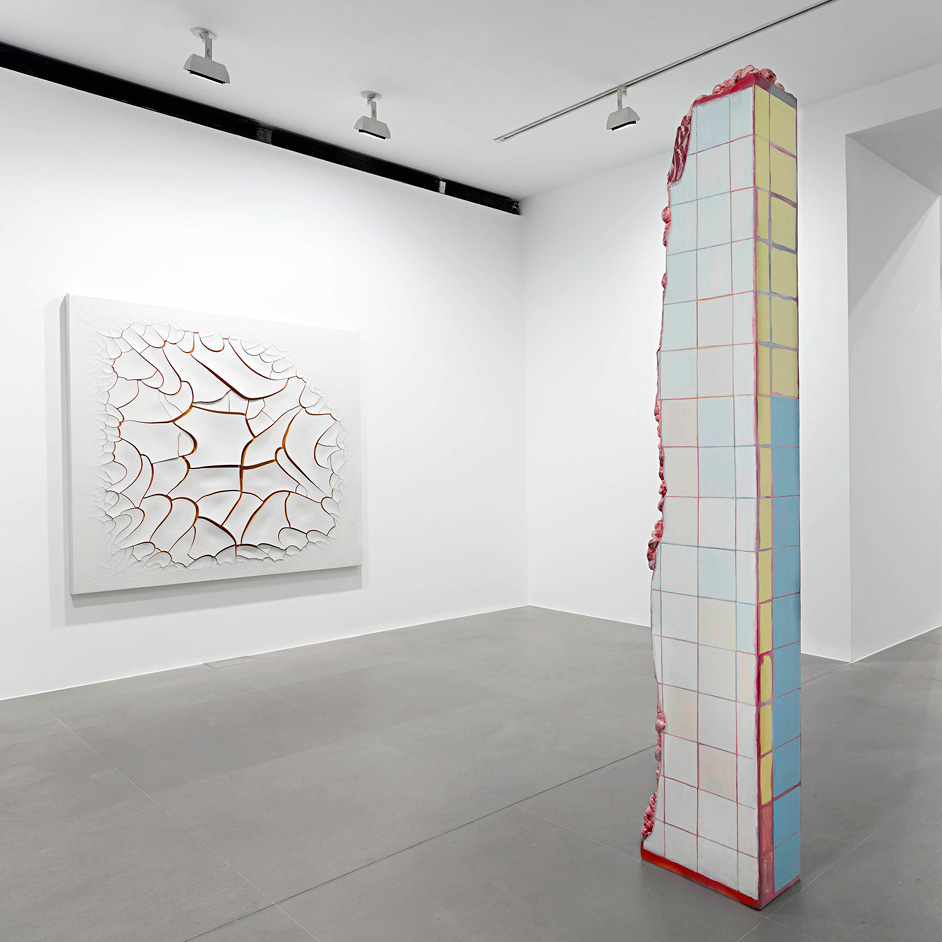ROME — The tile work of Adriana Varejão is beautiful blue baroque, but there’s a dark side wrapped up within it. Pulling her work from history, she’s not afraid to turn her eye toward those parts of history that most would like to forget. Her tiles exhibited at the Leah Maupin Gallery illustrate this. She’s famed in her home country of Brazil, where she was recently given free reign over the Olympic swimming pool at Rio de Janeiro, which she draped in tile-like blue and white art.
Above images: Installation views of Adriana Varejão, Azulejão, 2016-2017 at the Gagosian Gallery, Rome. Photographs from Wallpaper*
Her most recent show is at Gagosian Gallery’s location in Rome: Azulejão (October 1, 2016 – January 14, 2017). Her tile-inspired works are, this time, richly textured with feathery-looking cracks. Some still retain their edge with works that include columns that are cut away into sections revealing raw red flesh underneath. The gallery states:
Varejão’s “big tiles” are, in fact, rendered on canvas in plaster and oil paint. The plaster is applied thickly to canvases laid on the ground and then left to dry. During the drying process, cracks begin to appear, as if by some natural geological phenomenon, so that every surface is unique and unrepeatable. Within the span of twenty years, these square paintings have ranged slightly in scale, sometimes aggregating into environmentally scaled works such as the operatic Celacanto provoca maremoto (Coelacanth Provokes Seaquake) (2004–08), now housed in a custom-built pavilion at Instituto Inhotim, a spectacular art park and museum in Minas Gerais, Brazil.
In this work, the inscriptions of history, culture, landscape, geography and the human body that populated Varejão’s earlier paintings have been subsumed into a roiling delirium of blue and white patterns and fragmentary images, rendered in a grid of paintings to simulate a tiled wall of vast proportions. The works in the current exhibition, conceived specifically with the Rome gallery in mind, are Varejão’s largest single tile paintings to date, measuring 180 centimeters squared. Motifs, such as a cherub’s head, an architectural fragment, a rose, and a shell, painted in subtle variations of blue and white according to their specific historical referents, are enlarged to the point where they begin dissolving into opulent abstract gestures.
She told Wallpaper* in an interview that the works were drawn from a vast collection of historic tile images:
‘I based each of these paintings on Portuguese baroque tiles, their images and their object quality,’ she explains. ‘I chose the motifs from my huge archive of tile images, focusing in general on those with more abstract and geometrical qualities.’ Indeed, with a close look and a good dash of imagination, one can see how each painting is a dramatically enlarged close-up of a cherub’s head, an architectural fragment, a rose or a shell.”
About the Artist
Adriana Varejão was born in 1964 in Rio de Janeiro, Brazil, where she lives and works. Major museum collections include the Metropolitan Museum of Art, New York; Solomon R. Guggenheim Museum, New York; Museum of Contemporary Art San Diego; Tate Modern, London; Fondation Cartier pour l’art contemporain, Paris; Fundación “la Caixa,” Barcelona; Stedelijk Museum, Amsterdam; and Hara Museum, Tokyo. Selected solo institutional exhibitions include “Azulejões,” Centro Cultural Banco do Brasil, Rio de Janeiro and Brasília, Brazil (2001); “Chambre d’échos / Câmara de ecos,” Fondation Cartier pour l´art Contemporain, Paris (2005, travelled to Centro Cultural de Belém in Lisbon and DA2 in Salamanca, Spain); Hara Museum of Contemporary Art, Tokyo (2007); “Adriana Varejão – Histórias às Margens,” Museu de Arte Moderna de São Paulo, Brazil (2012, travelled to Museu de Arte Moderna do Rio de Janeiro, Brazil and Museo de Arte Latinoamericano de Buenos Aires (MALBA), Argentina in 2013); “Adriana Varejão,’ The Institute of Contemporary Art, Boston (2014); and “Adriana Varejão: Kindred Spirits,” Dallas Contemporary (2015). Varejão participated in the Bienal de São Paulo (1994 and 1998); the Biennial of Sydney (2001); SITE Santa Fe (2004); Mercosul Biennial in Visual Art, Brazil (1997, 2005, and 2015); the Istanbul Biennial (2011); the Bienal de Bucareste, Romania (2008); the Liverpool Biennial (1999 and 2006); “30x Bienal,” Fundação Bienal de São Paulo (2013); and the Bienal de Arte de Contemporânea de Coimbra, Portugal(2015). In 2008, the Galeria Adriana Varejão, a permanent pavilion dedicated to Varejão’s art, designed by Rodrigo Cerviño Lopez, was inaugurated at Inhotim Centro de Arte Contemporânea, Brumadinho, Minas Gerais, Brazil. In 2016 she was commissioned to produce a temporary mural based on Celacanto provoca maremoto to cover the entire facade of the Centro Aquatico for the Summer Olympics in Rio de Janeiro.
Do you love or loathe these works of contemporary ceramic art? Let us know in the comments.






I am not much of a coffee drerikn, but I love coffee. You may find it weird but I make more than five cups of coffee a day but only drink a cup each day. I make cups of coffee just for the reason of smelling the aroma. I love its floral, fruity smell. Have you heard about aroma therapy? Well, the aroma of the coffee does wonders to me.